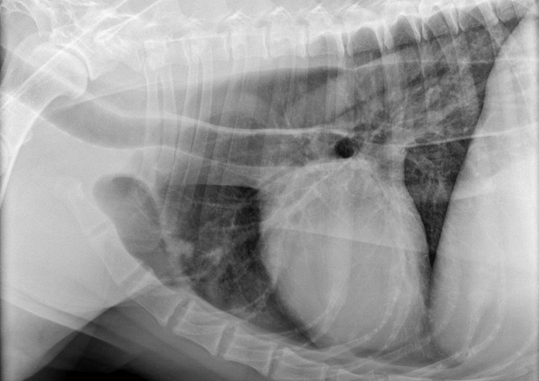
This article was updated on December 5th, 2022
Did you know there is a difference between vomiting and regurgitation? Vomiting is more of an active action with abdominal contraction and retching. Regurgitation is more passive, like a wet burp. Gross!… but important. The distinction between the two is important to a veterinarian because it may help find where the source of the problem is. Vomiting is usually a problem with the stomach and down, but regurgitation is typically the esophagus and up. A dilated esophagus is known as megaesophagus, and can usually be picked up by chest X-rays.

Causes of Megaesophagus
Megaesophagus has numerous causes. The main categories include nerve dysfunction and obstruction. These can be further subdivided into congenital (diseases they are born with) and acquired (obtained later in life). Diseases affecting the nerves prevent the muscles around the esophagus that normally move swallowed food from the mouth to the stomach. This is known as dismotility. An obstruction is an object that physically blocks the movement of food through the affected area. Unfortunately, most of the time, the underlying cause is not detectable. This is called idiopathic megaesophagus. Overall, congenital causes of megaesophagus are rare, and acquired causes are uncommon.
Breeds that are more common to have congenital nerve dysfunction of their esophagus include Great Danes, Irish Setters, pugs, some terriers, and schnauzers, to name a few. In these cases, the nerves did not develop all the way, leading to ineffective muscle contractions, without which cannot move food in a controlled way.
Acquired causes of dismotility include Myasthenia Gravis, hiatal hernia, esophagitis, and Addison’s Disease. Myasthenia Gravis is the most commonly diagnosed cause of megaesophagus (Mace et al., 2012). While it is usually autoimmune, it actually can be passed along to offspring, so technically, it can be a congenital cause as well. Also of note is that it may affect only the esophagus, or it can be more generalized, leading to weakness in other parts of the body.
A hiatal hernia, where a small portion of the stomach slides up into the chest, causes a large amount of gastric reflux. This then leads to severe esophagitis (inflammation of the esophagus), impeding the movement of the esophageal muscles. Other causes of esophagitis include swallowing sharp or caustic (corrosive agents like bleach and oven cleaner) substances. Addison’s Disease is a disease where an insufficient amount of cortisol or adrenaline is produced. This can also impair the muscle movement within the esophagus.
Physical obstructions leading to megaesophagus can also be congenital or acquired. A Persistent Right Aortic Arch (PRAA) is a condition where the aorta does not develop properly and creates a fibrous band that encircles and constricts the esophagus. This is called a vascular ring anomaly. Acquired conditions that lead to obstruction include a stricture or narrowing of the tube itself, or a tumor preventing food from moving all the way through to the stomach.
| Causes of Megaesophagus | Dismotility | Obstruction |
| Congeintal | breed-specific/hereditary | PRAA |
| Acquired | Myasthenia Gravis Hiatal hernia Esophagitis Addison’s Disease Iatrogenic | Stricture Tumor/mass |
Clinical Signs
Clinical signs include regurgitation, weight loss, and often coughing. Coughing is a product of aspiration pneumonia. Because the food does not make it all the way to the stomach, and often gets regurgitated up, some of that can accidentally be inhaled and go into the lungs. This can lead to an infection, and is called aspiration pneumonia. Aspiration pneumonia is a common complicating factor, for which the pet needs to be carefully monitored. In cases of congenital megaesophagus, clinical signs typically become apparent when the puppy transitions to solid foods. Acquired causes can occur anytime, but are more commonly middle to older aged dogs.
Treatments and Outcome
Treatment and prognosis depend on the underlying cause.
- Dogs born with nerve dysfunction of the esophagus may actually grow out of it, and may do just fine.
- Pups with PRAA can undergo a surgery performed by a specialist that snips the fibrous band, releasing the obstruction around the esophagus. Most dogs have a good long-term outcome, some have excellent, and few have poor outcomes. (Krebs et al., 2014)
- Myasthenia Gravis is most often medically managed and can have a complete recovery with dedicated owners and excellent nursing care, but may take over six months.
- Aspiration pneumonia can play a tremendous impact and, if not controlled, can decrease the prognosis. Aspiration pneumonia may require strong antibiotics and prolonged stays in the ICU with supplemented oxygen.
- Hiatal hernias and esophagitis can often be treated medically with antacids, but occasionally require surgical correction as well.
- Strictures can be managed by placing a dilating balloon and obstructing tumors can be surgically removed. However, these have a less optimistic prognosis.
Prognosis
Pets that do not receive the proper care can succumb to aspiration pneumonia and insufficient nutrition. This can lead to severe labored breathing, even respiratory fatigue or arrest. Severe infection or poor nutrition can lead to multi-organ dysfunction and death.

At home, nursing care includes proper nutritional regimens and vigilant respiratory watch. Foods that are beneficial in these cases include canned low-fat foods that can be made into a thin gruel and lapped up. Let’s also not forget the importance of gravity. Because dogs are on four legs, the esophagus is not up and down like in humans, but more horizontal, which is not great for getting the food down to the stomach.
There is an invention called a Bailey Chair that holds the dog upright while eating, thus making the path to the stomach more vertical, moving the food down to the stomach with the help of gravity. Dogs should typically stay in the upright position for about 15 minutes after each meal. Some dogs actually require feeding tubes that bypass the esophagus and deliver the calories directly into the stomach.
All in all dogs with megaesophagus can do quite well if detected early and treated properly. Depending on the underlying cause, it can sometimes be completely cured, and other times can be managed for years while maintaining a great quality of life.
FAQs
Can a Dog Survive Megaesophagus?
Yes, dogs can do well with either medical and/or surgical correction, depending on the underlying cause. Also, closely monitoring, minimizing, and aggressively treating aspiration pneumonia should it arise, will dramatically improve the prognosis.
Does Megaesophagus in Dogs Get Worse Over Time?
Usually if it is properly managed, the pet gets better. However, if the underlying cause is not addressed, or it is not treated appropriately, subsequent diseases such as aspiration pneumonia and poor nutrition can make the pet very sick, even become fatal.
How Quickly Does Megaesophagus Progress in Dogs?
Clinical signs of congenital megaesophagus typically occur during the weaning process. Because these puppies are not getting as much nutrition into them as their littermates, they are typically smaller. Clinical signs will worsen as more solid food is introduced.
Acquired causes may present acutely in the face of obstruction, and may be a little more gradual with dismotility disorders.
Can Dogs with Megaesophagus Drink Water?
Yes, but small frequent amounts from an elevated bowl is safer
Can Dogs with Megaesophagus Eat Dry Food?
It may be harder for dogs to swallow dry food, and for it to be moved through the esophagus and into the stomach. Liquid or gruel diets typically work much better, thus providing more nutrition and fewer bouts of regurgitation.
How Often Should You Feed a Dog with Megaesophagus?
Small, frequent meals may be beneficial, giving the esophagus less work to do at a time. However, the important thing is providing a gruel diet, and holding them upright for about 15 minutes after every meal.
Should I Put My Dog with Megaesophagus Down?
Many causes of megaesophagus are treatable, or at least manageable. However, keep in mind that it involves dedicated nursing care at home, including preparing special diets, keeping them upright after meals, and a very close respiratory watch to monitor for aspiration pneumonia. For best outcome, frequent vet visits, especially in the beginning, would be ideal for blood work, early signs of aspiration pneumonia, and weight monitoring. These steps can be time-consuming and expensive. Being prepared and having a clear dialogue with your veterinarian helps direct decision making.
Reference
Krebs, Ingar, et al. 2014. Short- and Long-Term Outcome of Dogs Following Surgical Correction of a Persistent Right Aortic Arch. JAAHA. https://doi.org/10.5326/JAAHA-MS-6034.
Mace, Sacha BA, DVM, DACVIM, et al. 2012. Megaesophagus. http://assets.prod.vetlearn.com.s3.amazonaws.com/5c/7773404e8311e1806d005056ad4734/file/PV0212_Mace_CE.pdf.
Disclaimer: This website's content is not a substitute for veterinary care. Always consult with your veterinarian for healthcare decisions. Read More.


Be the first to comment